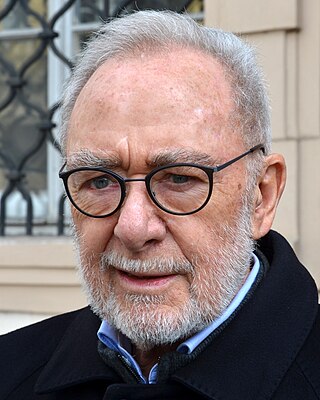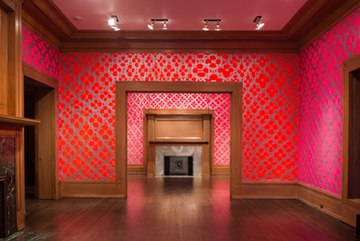
Helen Frankenthaler was an American abstract expressionist painter. She was a major contributor to the history of postwar American painting. Having exhibited her work for over six decades, she spanned several generations of abstract painters while continuing to produce vital and ever-changing new work. Frankenthaler began exhibiting her large-scale abstract expressionist paintings in contemporary museums and galleries in the early 1950s. She was included in the 1964 Post-Painterly Abstraction exhibition curated by Clement Greenberg that introduced a newer generation of abstract painting that came to be known as color field. Born in Manhattan, she was influenced by Greenberg, Hans Hofmann, and Jackson Pollock's paintings. Her work has been the subject of several retrospective exhibitions, including a 1989 retrospective at the Museum of Modern Art in New York City, and been exhibited worldwide since the 1950s. In 2001, she was awarded the National Medal of Arts.

Gerhard Richter is a German visual artist. Richter has produced abstract as well as photorealistic paintings, and also photographs and glass pieces. He is widely regarded as one of the most important contemporary German artists and several of his works have set record prices at auction.

Elaine Frances Sturtevant, also known professionally as Sturtevant, was an American artist. She achieved recognition for her carefully inexact repetitions of other artists' works.
Callum Innes is a Scottish abstract painter, a former Turner Prize nominee and winner of the Jerwood Painting Prize. He lives and works in Edinburgh, Scotland.
David Moos is the president of David Moos Art Advisory and a co-founder of The Museum Exchange.

Arturo Herrera is a Venezuelan-born (1959), Berlin-based visual artist known for wide-ranging work that is rooted in the practice of collage. His colorful, often rhythmic art intertwines bits of pop iconography, gestural marks and nonrepresentational shapes using pictorial strategies of fragmentation, repetition, effacement and dislocation. The resulting imagery often balances between abstraction and figuration, detached from inherent narratives yet vaguely familiar. Critics suggest that this ambiguity engages memory, fantasy and a viewer's unconscious private interpretive schemes, evoking a multiplicity of references and readings. In 2020, Art in America writer Ara H. Merjian described Herrera's practice—which includes works on paper, paintings, reliefs, sculpture, public art and books—as "chameleonic as [it] is consistent," one that "breathes life into modernist collage, exploring the tensions between exactitude and spontaneity, placement and displacement."
Tony Tasset is an American multimedia artist. His works consists mainly of video, bronze, wax, sculpture, photography, film, and taxidermy. He has exhibitions that can be seen in Dallas, Chicago, New York, Los Angeles, Germany, Canada, Portugal, Italy, Ecuador, and London.
Alvin D. Loving Jr., better known as Al Loving, was an African-American abstract expressionist painter. His work is known for hard-edge abstraction, fabric constructions, and large paper collages, all exploring complicated color relationships.

Shirana Shahbazi is an Iranian-born photographer who now lives in Switzerland. Her work includes installations and large prints of conceptual photography.

Phyllis Bramson is an American artist, based in Chicago and known for "richly ornamental, excessive and decadent" paintings described as walking a tightrope between "edginess and eroticism." She combines eclectic influences, such as kitsch culture, Rococo art and Orientalism, in juxtapositions of fantastical figures, decorative patterns and objects, and pastoral landscapes that affirm the pleasures and follies of romantic desire, imagination and looking. Bramson shares tendencies with the Chicago Imagists and broader Chicago tradition of surreal representation in her use of expressionist figuration, vernacular culture, bright color, and sexual imagery. Curator Lynne Warren wrote of her 30-year retrospective at the Chicago Cultural Center, "Bramson passionately paints from her center, so uniquely shaped in her formative years […] her lovely colors, fluttery, vignette compositions, and flowery and cartoony imagery create works that are really like no one else's. Writer Miranda McClintic said that Bramson's works "incorporate the passionate complexity of eastern mythology, the sexual innuendos of soap operas and sometimes the happy endings of cartoons." Bramson's work has been exhibited in exhibitions and surveys at the Museum of Contemporary Art, Chicago (MCA), the Art Institute of Chicago, the Smithsonian Institution, and Corcoran Gallery of Art. In more than forty one-person exhibitions, she has shown at the New Museum, Fort Wayne Museum of Art, Boulder Art Museum, University of West Virginia Museum, and numerous galleries. She has been widely reviewed and recognized with John S. Guggenheim and Rockefeller foundation grants and the Anonymous Was A Woman Award, among others. She was one of the founding members of the early women's art collaborative Artemisia Gallery and a long-time professor at the School of Art and Design at the University of Illinois at Chicago, until retiring in 2007.
Kay Rosen is an American painter. Rosen's paintings are included in the collections of the Art Institute of Chicago, the Museum of Contemporary Art, Los Angeles, and the Museum of Modern Art and Whitney Museum of American Art in New York City. Rosen lives in Gary, Indiana, and New York.

Candida Alvarez is an American artist and professor, known for her paintings and drawings.
Julia Fish is an American artist whose paintings have a deceptive simplicity. She paints in oil on stretched rectangular canvases of varying size. By means of close observation of everyday subjects—leaves of a tree seen through a window, a section of floor tiles, an old fashioned light fixture— she makes, as one critic says, "quiet, abstract manifestations of observed realities." She is a studio artist who paints not what she sees in an instant but rather what she observes continuously, day after day. The result, she says, is not so much temporal as durational. Her paintings compress many instances of observation so as to become, as she sees it, "a parallel system to a lived experience." The paintings lack spatial orientation and, as a critic says, can "be described as both highly realistic and abstract without compromising either term." In 2008, Alan G. Artner, writing in the Chicago Tribune, said "This is work of small refinements and adjustments. The world of everyday things generates it, but Fish's qualities of seeing and touch elevate the things to a plane on which they leave behind their humble character."

Rodney Carswell is an American abstract artist. He first gained recognition for human-scaled, geometric paintings that feature exposed, projected support structures, creating interplay between sculptural presence and richly painted pictorial surfaces. His recent paintings eschew the superstructures and evoke a greater sense of immediacy, playfulness, and narrative. Critics often describe Carswell's work as uncanny, elusive or quirky, for its tendency to negotiate "in-between" spaces and embrace contradictions such as order and instability, intention and accident, or back and front. Employing irregularly shaped canvasses, thick supports, and openings or holes that reveal the stretcher construction and walls behind them, works like 3 (1994) often occupy a place between painting and sculpture. In a similar way, Carswell uses the modernist languages of Minimalism, Suprematism and Constructivism, yet eludes those categories with postmodern allusions to architecture, the body and spiritual iconography, and with his process-oriented, "hand-made" surfaces. In his essay for Carswell's mid-career retrospective at Chicago's Renaissance Society, Los Angeles Times critic David Pagel suggested that his understated paintings worked their way into the one's consciousness in a "supple, somewhat unsettling manner" that achieves a subtle, but lingering shift in perception.

Helen O'Toole is an Irish-born painter based in the United States, who is known for abstract paintings suggestive of landscape. She has exhibited throughout Ireland and the United States, in Singapore, and at venues including the San Francisco Museum of Modern Art, Portland Art Museum, Chicago Cultural Center, Tacoma Art Museum, and Institute of Contemporary Arts Singapore. Her work has been featured in the journals Artforum, Arts Magazine, New Art Examiner, and Zyzzyva, as well as the Chicago Tribune,The Irish Times, Seattle Post-Intelligencer, and National Public Radio. Art writers frequently discuss the interplay in her work between abstraction, the evocation of otherworldly light, land and space, and a commitment to investigating meaning through a painting process akin to the processes of cultivation and excavation. Artforum critic James Yood wrote, "echoing the often inchoate quality of nature, her paint surges toward mystery and hints at a kind of chiaroscuro of the spirit"; curator Bonnie Laing-Malcomson suggests her "richly colored monumental paintings evoke the moody landscape of her rural Irish homeland, summoning the force of J. M. W. Turner and Mark Rothko." She has been recognized with a Guggenheim Fellowship in Fine Arts, a Contemporary Northwest Art Award, and a Pollock-Krasner Foundation Award (2013), among other awards. O'Toole lives in Seattle, Washington and is Professor of Art and Chair of the Painting and Drawing Program at the University of Washington.
Ann Mandelbaum is an American artist and photographer. She has an MA in Media Studies from The New School and an MFA from Pratt Institute in Painting and Drawing. She retired in 2021 after over 40 years teaching Fine Art and Photography at Pratt Institute.

Frank Piatek is an American artist, known for abstract, illusionistic paintings of tubular forms and three-dimensional works exploring spirituality, cultural memory and the creative process. Piatek emerged in the mid-1960s, among a group of Chicago artists exploring various types of organic abstraction that shared qualities with the Chicago Imagists; his work, however relies more on suggestion than expressionistic representation. In Art in Chicago 1945-1995, the Museum of Contemporary Art, Chicago (MCA) described Piatek as playing “a crucial role in the development and refinement of abstract painting in Chicago" with carefully rendered, biomorphic compositions that illustrate the dialectical relationship between Chicago's idiosyncratic abstract and figurative styles. Piatek's work has been exhibited at institutions including the Whitney Museum, Art Institute of Chicago, MCA Chicago, National Museum, Szczecin in Poland, and Terra Museum of American Art; it belongs to the public art collections of the Art Institute of Chicago and MCA Chicago, among others. Curator Lynne Warren describes Piatek as "the quintessential Chicago artist—a highly individualistic, introspective outsider" who has developed a "unique and deeply felt world view from an artistically isolated vantage point." Piatek lives and works in Chicago with his wife, painter and SAIC professor Judith Geichman, and has taught at the School of the Art Institute of Chicago since 1974.

Carla Arocha is a Venezuelan artist recognized for her work grounded in Minimalism, design, and geometric abstraction, specifically examples from her native Venezuela. She lives and works in Antwerp. Her work has been exhibited internationally since the mid-1990s.

Judith Simonian is an American artist known for her montage-like paintings and early urban public art. She began her career as a significant participant in an emergent 1980s downtown Los Angeles art scene that spawned street art and performances, galleries and institutions such as Los Angeles Contemporary Exhibitions (LACE) and Los Angeles Institute of Contemporary Art (LAICA), before moving to New York City in 1985.

Harriet Korman is an American abstract painter based in New York City, who first gained attention in the early 1970s. She is known for work that embraces improvisation and experimentation within a framework of self-imposed limitations that include simplicity of means, purity of color, and a strict rejection of allusion, illusion, naturalistic light and space, or other translations of reality. Writer John Yau describes Korman as "a pure abstract artist, one who doesn’t rely on a visual hook, cultural association, or anything that smacks of essentialization or the spiritual," a position he suggests few post-Warhol painters have taken. While Korman's work may suggest early twentieth-century abstraction, critics such as Roberta Smith locate its roots among a cohort of early-1970s women artists who sought to reinvent painting using strategies from Process Art, then most associated with sculpture, installation art and performance. Since the 1990s, critics and curators have championed this early work as unjustifiably neglected by a male-dominated 1970s art market and deserving of rediscovery.

















